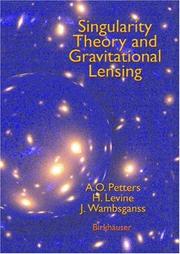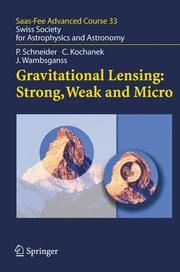| Listing 1 - 6 of 6 |
Sort by
|
Book
ISBN: 366256002X Year: 2012 Publisher: Berlin, Heidelberg : Springer Berlin Heidelberg : Imprint: Springer,
Abstract | Keywords | Export | Availability | Bookmark
 Loading...
Loading...Choose an application
- Reference Manager
- EndNote
- RefWorks (Direct export to RefWorks)
Gibt es eine zweite Erde? Wieso haben Kometen einen Schweif? Ist das Universum unendlich? Warum ist Pluto kein Planet mehr? Kann uns der Himmel auf den Kopf fallen? Das Universum für alle beantwortet Ihnen diese und viele weiteren Fragen zu Sonne und Mond, zu Sternen und Galaxien, das Buch lädt Sie ein zu einer Reise durchs Weltall! Sie werden erfahren, warum die Sterne funkeln, wieso es den 29. Februar so selten gibt, was es mit Einstein-RIngen auf sich hat und wie die Astronomen das Weltall vermessen. In jedem der 70 Kapitel wird in leicht verständlicher Sprache eine astronomische Fragestellung erläutert. Reich bebildert und unterhaltsam erklärt bieten Ihnen erstklassige Experten kurze und kurzweilige Geschichten aus dem Universum: Von der Sternschnuppe bis zum Urknall, von der Sternengeburt bis zur Supernova-Explosion, vom Saturn bis zu Schwarzen Löchern. Diese Buch beruht auf der preisgekrönten Vortragsreihe „Uni(versum) für alle! – Halbe Heidelberger Sternstunden“, bei der von April bis Juli 2011 Heidelberger Astronominnen und Astronomen der interessierten Öffentlichkeit in 70 Kurzvorträgen faszinierende Themen der Astronomie näher gebracht haben. Am Ende jedes Kapitels werden Sie zu den Videos dieser Vorträge geleitet, die Sie kostenlos über YouTube anschauen können. Tauchen Sie also ein in die Welt der Galaxien und Schwarzen Löcher, genießen Sie die großartigen astronomischen Fotografien und erfreuen Sie sich an den anregenden Texten. Viel Spaß beim Blättern, Lesen und Staunen! Der Autor Prof. Dr. Joachim Wambsganß ist seit 2004 Direktor des Astronomischen Rechen-Instituts am Zentrum für Astronomie der Universität Heidelberg. Neben seinen astrophysikalischen Forschungen und der Lehrtätigkeit an der Universität widmet er sich seit vielen Jahren auf ganz verschiedenartige Weise auch der astronomischen Öffentlichkeitsarbeit. Für das Projekt „Universum für alle!” wurde er 2014 mit dem Werner und Inge Grüter-Preis für Wissenschaftsvermittlung und 2017 mit dem Georg-Kerschensteiner-Preis der Deutschen Physikalischen Gesellschaft ausgezeichnet.
Astronomy. --- Astrophysics. --- Physics. --- Popular Science in Astronomy. --- Astronomy, Astrophysics and Cosmology. --- Popular Science in Physics.

ISBN: 0817636684 1461266335 1461201454 Year: 2001 Publisher: Basel ; Boston, MA ; Stuttgart : Birkhäuser,
Abstract | Keywords | Export | Availability | Bookmark
 Loading...
Loading...Choose an application
- Reference Manager
- EndNote
- RefWorks (Direct export to RefWorks)
This monograph, unique in the literature, is the first to develop a mathematical theory of gravitational lensing. The theory applies to any finite number of deflector planes and highlights the distinctions between single and multiple plane lensing. Introductory material in Parts I and II present historical highlights and the astrophysical aspects of the subject. Among the lensing topics discussed are multiple quasars, giant luminous arcs, Einstein rings, the detection of dark matter and planets with lensing, time delays and the age of the universe (Hubble’s constant), microlensing of stars and quasars. The main part of the book---Part III---employs the ideas and results of singularity theory to put gravitational lensing on a rigorous mathematical foundation and solve certain key lensing problems. Results are published here for the first time. Mathematical topics discussed: Morse theory, Whitney singularity theory, Thom catastrophe theory, Mather stability theory, Arnold singularity theory, and the Euler characteristic via projectivized rotation numbers. These tools are applied to the study of stable lens systems, local and global geometry of caustics, caustic metamorphoses, multiple lens images, lensed image magnification, magnification cross sections, and lensing by singular and nonsingular deflectors. Examples, illustrations, bibliography and index make this a suitable text for an undergraduate/graduate course, seminar, or independent these project on gravitational lensing. The book is also an excellent reference text for professional mathematicians, mathematical physicists, astrophysicists, and physicists.
Differential geometry. Global analysis --- Physics. --- Applied mathematics. --- Engineering mathematics. --- Differential geometry. --- Astrophysics. --- Mathematical Methods in Physics. --- Applications of Mathematics. --- Differential Geometry. --- Astrophysics and Astroparticles. --- Astronomical physics --- Astronomy --- Cosmic physics --- Physics --- Differential geometry --- Engineering --- Engineering analysis --- Mathematical analysis --- Natural philosophy --- Philosophy, Natural --- Physical sciences --- Dynamics --- Mathematics
Digital
ISBN: 9783540303107 Year: 2006 Publisher: Berlin, Heidelberg Springer-Verlag Berlin Heidelberg
Abstract | Keywords | Export | Availability | Bookmark
 Loading...
Loading...Choose an application
- Reference Manager
- EndNote
- RefWorks (Direct export to RefWorks)
Space research --- Cosmology --- Astrophysics --- Theory of relativity. Unified field theory --- astrofysica --- relativiteitstheorie --- ruimte (astronomie) --- kosmologie
Book
ISBN: 9783540303107 Year: 2006 Publisher: Berlin Heidelberg Springer Berlin Heidelberg
Abstract | Keywords | Export | Availability | Bookmark
 Loading...
Loading...Choose an application
- Reference Manager
- EndNote
- RefWorks (Direct export to RefWorks)
The theory, observations, and applications of gravitational lensing constitute one of the most rapidly growing branches of astrophysics. The gravitational deflection of light generated by mass concentrations along a light path produces magnification, multiplicity, and distortion of images and delays photon propagation from one line of sight relative to another. The huge amount of scientific work on gravitational lensing produced over the last decade has clearly revealed its already substantial and wide impact and its potential for future astrophysical applications. The up-to-date contributions in this book are based on the lecture notes of the 33rd Saas-Fee Advanced Course of the Swiss Society of Astronomy and Astrophysics, entitled Gravitational Lensing: Strong, Weak, and Micro. The book comprises four complementary parts, written by leading experts in the field, constituting a genuine textbook about gravitational lensing: ¢ Peter Schneider - Part 1: Introduction to Gravitational Lensing and Cosmology ¢ Christopher Kochanek - Part 2: Strong Gravitational Lensing ¢ Peter Schneider - Part 3: Weak Gravitational Lensing ¢ Joachim Wambsganss - Part 4: Gravitational Microlensing Students and researchers alike will benefit from this comprehensive presentation of the astrophysical and astronomical aspects of gravitational lensing.
Space research --- Cosmology --- Astrophysics --- Theory of relativity. Unified field theory --- astrofysica --- relativiteitstheorie --- ruimte (astronomie) --- kosmologie
Book

ISBN: 9783825356811 Year: 2009 Volume: 10 Publisher: Heidelberg Universitätsverlag Winter
Abstract | Keywords | Export | Availability | Bookmark
 Loading...
Loading...Choose an application
- Reference Manager
- EndNote
- RefWorks (Direct export to RefWorks)
Book history
---
Universität Heidelberg
---
094:52
---
094.2 <43 HEIDELBERG>
---
Oude en merkwaardige drukken. Kostbare en zeldzame boeken. Preciosa en rariora-:-Astronomie. Astrofysica. Ruimteonderzoek. Geodesie
---
Oude drukken: bibliotheekcatalogi--


ISBN: 3540303103 354030309X 3642067778 9783642067778 Year: 2006 Publisher: Berlin, Heidelberg : Springer Berlin Heidelberg : Imprint: Springer,
Abstract | Keywords | Export | Availability | Bookmark
 Loading...
Loading...Choose an application
- Reference Manager
- EndNote
- RefWorks (Direct export to RefWorks)
The theory, observations, and applications of gravitational lensing constitute one of the most rapidly growing branches of astrophysics. The gravitational deflection of light generated by mass concentrations along a light path produces magnification, multiplicity, and distortion of images and delays photon propagation from one line of sight relative to another. The huge amount of scientific work on gravitational lensing produced over the last decade has clearly revealed its already substantial and wide impact and its potential for future astrophysical applications. The up-to-date contributions in this book are based on the lecture notes of the 33rd Saas–Fee Advanced Course of the Swiss Society of Astronomy and Astrophysics, entitled Gravitational Lensing: Strong, Weak, and Micro. The book comprises four complementary parts, written by leading experts in the field, constituting a genuine textbook about gravitational lensing: • Peter Schneider – Part 1: Introduction to Gravitational Lensing and Cosmology • Christopher Kochanek – Part 2: Strong Gravitational Lensing • Peter Schneider – Part 3: Weak Gravitational Lensing • Joachim Wambsganss – Part 4: Gravitational Microlensing Students and researchers alike will benefit from this comprehensive presentation of the astrophysical and astronomical aspects of gravitational lensing.
Gravitational lenses --- Lenses --- Astronomy. --- Astrophysics and Astroparticles. --- Astronomy, Astrophysics and Cosmology. --- Cosmology. --- Classical and Quantum Gravitation, Relativity Theory. --- Astronomy, Observations and Techniques. --- Gravitational lenses. --- Astrophysics. --- Gravitation. --- Observations, Astronomical. --- Astronomy—Observations. --- Astronomical observations --- Observations, Astronomical --- Field theory (Physics) --- Matter --- Physics --- Antigravity --- Centrifugal force --- Relativity (Physics) --- Astronomy --- Deism --- Metaphysics --- Astronomical physics --- Cosmic physics --- Properties
| Listing 1 - 6 of 6 |
Sort by
|

 Search
Search Feedback
Feedback About UniCat
About UniCat  Help
Help News
News